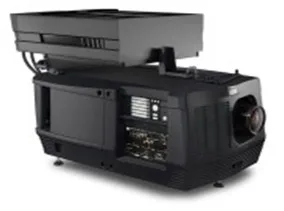RGB laser projectors are the top of the pyramid in terms of image performance. These are being slated to the largest flagship venues today. But laser-phosphor based models are no poised to offer a new solution for mainstream theaters as well. Even though most exhibitors have recently upgraded to digital cinema platforms, laser phosphor solutions could very well see strong adoption because of the clear benefits they offer.
For example, according to Goran Stojmenovik, the laser phosphor projector product manager at Barco, the laser phosphor (LP) models are 45% more efficient than comparable Xenon lamp based projectors for the cinema. That means a big savings in electrical costs. While electric rates vary widely, Stojmenovik estimates that on average, the electrical savings could be around $2,000 per year.
And then there are savings in lamp replacement costs. For the 18K lumen model, that is usually powered by a 4kW Xenon lamp that will have to be replaced 3-4 times per year on average. Some exhibitors replace lamps on a time used schedule or when brightness falls to a certain level, but that level can vary.
The projector can be operated in two modes: standard and constant brightness. In the standard mode, you start running the projector at the rated output (14 fL in 2D mode and 7 fL in 3D mode). Over time the brightness will decrease, as with lamp-based solution. In Standard mode, you will reach the 50% light output point at 30,000 hours when showing 2D content. If you show only 3D content, the lasers will still be at 80% of their initial brightness at 30,000 hours..
In the constant output mode, you start operating the projector at a lower lumen level. To do this and maintain the DCI brightness levels, you have to go to a smaller screen or to a screen with higher gain. In this case, the lasers are under driven initially and the drive current increases over time to maintain brightness.
LP models cost more than Xenon models and the savings in lamp replacement costs will vary as exhibitors have a range of pricing they pay for lamps. But the payback for a LP model vs. a Xenon model is 5-6 years on average, thinks Stojmenovik.
Barco will offer pre-built LP models as well as a retrofit solution for exhibitors. The solution replaces the Xenon lamp housing with a new cooler unit. This is a not a chiller as is used with the RGB projectors, but rather a radiative cooling unit for the liquid that is circulated to cool the blue lasers and the phosphor wheel. It connects to the same exhaust system used for the Xenon lamp.
Stojmenovik also described the performance improvements over their Xenon versions as well. For example, the contrast is 10% better at 2200:1 in the LP model, apparently because of a smaller étendue and collection efficiency for the 0.98” DMD chip set. The uniformity is also better. The center to corner brightness level in a Xenon projector is about 60% whereas in the LP model it is 75%. There is also no chance for flickering which can occur as lamps age.
For the cinema market, the projectors must achieve the P3 color gamut, which these models do. Red and green are derived from the yellow phosphor while the blue channel comes from the blue lasers. Apparently, simple diffusers are sufficient to de-speckle the blue.
The first units of Barco’s laser phosphor series will be installed in China as Barco has a long standing relationship with the China Film Group.
We also asked Stojmenovik about the use of LP projectors in non-theatrical markets. He noted that for these markets, the P3 gamut is not required so the color filters can be less aggressive, allowing higher brightness. In the rental and staging market, the run times are short, but the projectors need to be quite rugged with solid state projectors better than lamp-based in this regard.
Most other installations feature longer run times, so the lamp cost, maintenance cost and power savings offer benefits over lamp versions. There are no lamp disposal issues, no chance of lamp explosion and the associated warranty, plus no flicker concerns. LP sources are more green than lamps, which is another key selling point. And, you get the uniformity and contrast benefits mentioned above.
Look for Barco to showcase ProAV LP solutions at ISE with product launches in the InfoComm time frame. In addition, Barco plans to expand LP into other cinema platforms including its B series projectors and low end platforms as well. (CC)

